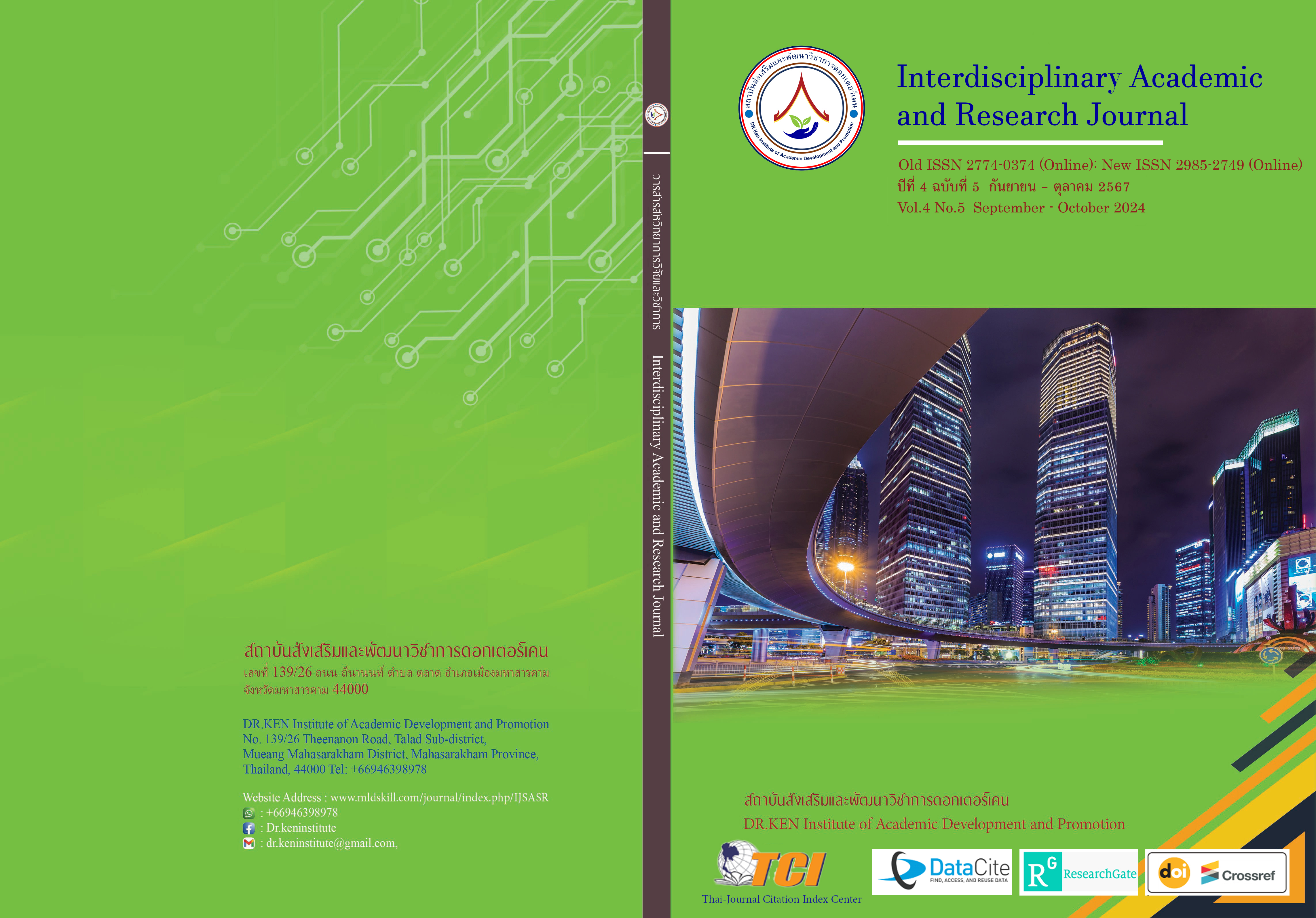Academic Leadership of Educational Institution Administrators under the Jurisdiction of Saraburi Primary Educational Service Office Area 2
DOI:
https://doi.org/10.60027/iarj.2024.277019Keywords:
Leadership; , Academic leaders; , Educational institution administratorsAbstract
Background and Aims: Education is a process that enhances knowledge and skills in individuals. To be able to live effectively in society It is a tool that promotes learning for everyone from birth and throughout life, through a variety of formats suitable for each age group. Educational institution administrators need to have academic leadership qualities. which is considered an important factor in the management of educational institutions Because educational institutions have unique characteristics that are different from general organizations. This research therefore has the following objectives: (1) To study the academic leadership level of educational institution administrators under the Saraburi Primary Educational Service Office Area 2. (2) To compare the academic leadership level of educational institution administrators according to various characteristics such as gender, age, and size of the educational institution. And (3) to study the possibility of developing the academic leadership of educational institution administrators under the Saraburi Primary Educational Service Office Area 2.
Methodology: The sample used in the research consisted of 317 personnel from the Saraburi Primary Educational Service Office Area 2, which was obtained by stratified random sampling. The tools used in the research are a questionnaire with 5 rating scales, with IOC values between 0.80 and 1.00. And had a confidence value of 0.76. In addition, a structured interview was used as an additional tool. Statistics used in data analysis include frequency, percentage, mean, and standard deviation, T-test (t-test), and F-test.
Results: The results of the research found that: (1) The academic leadership of educational institution administrators under the Saraburi Primary Educational Service Office Area 2 was overall at the "high" level. When considering each aspect, it was found that the academic leadership of Executives is at a "high" level in every aspect. (2) The results of the analysis of the comparison of opinions on academic leadership of school administrators according to various characteristics, including gender and age, found that there were no statistical differences. But when classified according to the size of the educational institution It was found that there was a statistically significant difference at the .05 level. (3) Guidelines for developing academic leadership of educational institution administrators under the Saraburi Primary Educational Service Office Area 2 found that: administrators should establish a committee to evaluate and monitor the implementation of the curriculum. Including internal supervision creates an environment that is conducive to teaching and learning. Support teachers to receive academic training that is consistent with the goals of the educational institution. There is a meeting of teachers to jointly consider the educational progress of the educational institution.
Conclusion: Administrators have the knowledge and ability to lead educational institutions to progress. Must have knowledge and ability in academic work. Promote a teaching and learning atmosphere within educational institutions. Evaluate and monitor the progress of staff and students for maximum efficiency.
References
กิตติภพ ภวณัฐกุลธร. (2566). การศึกษาภาวะผู้นำทางวิชาการในยุคดิจิทัลของผู้บริหารสถานศึกษาที่ส่งผลต่อการดำเนินงาน การประกันคุณภาพภายในสถานศึกษา สังกัดสำนักงานเขตพื้นที่การศึกษามัธยมศึกษากรุงเทพมหานคร เขต 2. สิกขา วารสารศึกษาศาสตร์, 10(2), 47 – 58.
ณัฐนิช สุรสิงห์ไกรสร. (2565). ภาวะผู้นำทางวิชาการของผู้บริหารสถานศึกษาในศตวรรษที่ 21. กรุงเทพฯ: ครุศาสตรมหาบัณฑิต สาขาวิชาการบริหารการศึกษา มหาวิทยาลัยราชภัฏสวนสุนันทา.
เทอดศักดิ์ ไชยสมปาน. (2563). บทความปัญหาการศึกษาไทยและแนวทางการแก้ไข. Retrieved on 12 Sep 2023: http://goto know.org/blog/jed/59979.
นพวนา วิภักดิ์. (2551). ความสัมพันธ์ระหว่างภาวะผู้นำทางวิชาการของผู้บริหารกับประสิทธิผล โรงเรียนประถมศึกษา สังกัดสำนักงานเขตพื้นที่การศึกษาหนองคาย. ครุศาสตรมหาบัณฑิต สาขาการบริหารการศึกษา มหาวิทยาลัยราชภัฏอุดรธานี. อุดรธานี.
นรินทร์พร เขตชมภู. (2566). แนวทางการพัฒนาภาวะผู้นำทางวิชาการของผู้บริหารสถานศึกษา สังกัดสำนักงานเขตพื้นที่การศึกษาประถมศึกษามหาสารคาม เขต 2. วารสารสถาบันวิจัยและพัฒนา มหาวิทยาลัยราชภัฏมหาสารคาม, 10(2), 563 – 578.
บุญชม ศรีสะอาด. (2556). การวิจัยเบื้องต้น. พิมพ์ครั้งที่ 9. กรุงเทพฯ : สุวรียาสาส์น.
พงศธร สารศรี. (2566). การศึกษาภาวะผู้นำทางวิชาการของผู้บริหารสถานศึกษา สังกัดสำนักงานเขตพื้นที่การศึกษาประถมศึกษาบุรีรัมย์ เขต 3. วารสารมหาจุฬานาครทรรศน์, 10(2), 27 – 39.
พิมพิชญา จงเกียรติกาญจน์. (2553). ความสัมพันธ์ระหว่างภาวะผู้นำทางวิชาการของผู้บริหารสถานศึกษากับประสิทธิผลของโรงเรียนเอกชนระดับประถมศึกษา สังกัดสำนักงานเขตพื้นที่การศึกษาอุดรธานี. วิทยานิพนธ์ปริญญามหาบัณฑิต สาขาบริหารการศึกษา, มหาวิทยาลัยราชภัฏอุดรธานี. อุดรธานี.
วรวุฒิ ศรีสวัสดิ์. (2566). ภาวะผู้นำทางวิชาการของผู้บริหารสถานศึกษาระดับประถมศึกษาตามทัศนะของครูอำเภอท่ายาง จังหวัดเพชรบุรี. วารสารรัชต์ภาคย์ (สาขามนุษยศาสตร์และสังคมศาสตร์), 17(51), 79 – 91.
สำนักงานเขตพื้นที่การศึกษาประถมศึกษาสระบุรี เขต 2. (2566). แผนปฏิบัติการสำนักงานเขตพื้นที่การศึกษาประถมศึกษาสระบุรี เขต 2 ประจำปีการศึกษา 2566. สำนักงานเขตพื้นที่การศึกษาประถมศึกษาสระบุรี เขต 2. สระบุรี.
เสกสรรค์ สนวา ฉัตรณรงค์ศักดิ์ สุธรรมดี และวิไลลักษณ์ ขาวสะอาด. (2561). คุณลักษณะของผู้นำองค์การภาครัฐสมัยใหม่. วารสารมนุษยศาสตร์และสังคมศาสตร์ มหาวิทยาลัยราชภัฏสุรินทร์, 20 (S), 399-411.
Cavazos, J. M. (1999). The instructional leadership of high school principals in successful Hispanic Majority high schools. Ph.D. Dissertation. Factory of Gradual school. The University of Texas at Austin.
Heinich, R., Molenda, M., Russell, J. D., & Smaldino, S. E. (2001). Instructional media and technologies for learning. 7th edition, Englewood Cliffs, NJ: Prentice Hall.
Krejcie, R. V., & Morgan, D. W. (1970). Determining sample size for research activities. Educational and Psychological Measurement, 30(3), 607–610. DOI: https://doi.org/10.1177/001316447003000308
Downloads
Published
How to Cite
Issue
Section
License
Copyright (c) 2024 Interdisciplinary Academic and Research Journal

This work is licensed under a Creative Commons Attribution-NonCommercial-NoDerivatives 4.0 International License.
Copyright on any article in the Interdisciplinary Academic and Research Journal is retained by the author(s) under the under the Creative Commons Attribution-NonCommercial-NoDerivatives 4.0 International License. Permission to use text, content, images, etc. of publication. Any user to read, download, copy, distribute, print, search, or link to the full texts of articles, crawl them for indexing, pass them as data to software, or use them for any other lawful purpose. But do not use it for commercial use or with the intent to benefit any business.
















.png)


